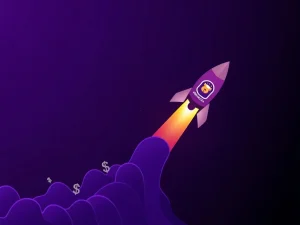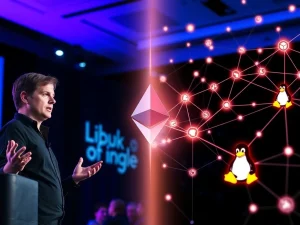Ethereum’s Pivotal Fusaka Upgrade: Boosting Gas Limit to 45M for Unprecedented Scalability

The world of decentralized finance (DeFi) is constantly evolving, and at its heart lies Ethereum, the foundational blockchain for countless innovations. For anyone invested in the future of digital assets, news of significant network upgrades is always met with keen interest. Today, all eyes are on the upcoming Ethereum Fusaka upgrade, a pivotal moment poised to enhance the network’s efficiency and bolster its position in the competitive blockchain landscape. Scheduled for November 5, 2025, this isn’t just another technical tweak; it’s a strategic move designed to tackle some of Ethereum’s most pressing challenges, particularly concerning its ability to handle more transactions and maintain its dominance.
What is the Ethereum Fusaka Upgrade and Why Does it Matter?
The Ethereum Fusaka upgrade, slated for November 5, 2025, represents a significant leap forward in Ethereum’s ongoing journey towards enhanced scalability and performance. This isn’t a minor patch; it’s a comprehensive network overhaul that integrates 11 Ethereum Improvement Proposals (EIPs). These EIPs are carefully selected to address critical areas, ranging from core protocol adjustments to security enhancements. The overarching goal is clear: to fortify Ethereum’s infrastructure, making it more robust and capable of supporting the burgeoning ecosystem of decentralized applications (dApps) and financial services.
One of the primary drivers behind Fusaka is Ethereum’s strategic imperative to remain competitive. In recent years, the blockchain space has seen an explosion of innovation, with rival Layer 1 (L1) blockchains like Solana and a multitude of Layer 2 (L2) scaling solutions offering faster transaction speeds and lower fees. Ethereum, despite its first-mover advantage and vast developer community, has often faced criticism for its high gas fees and network congestion during peak demand. The Fusaka upgrade is a direct response to these pressures, aiming to bridge the performance gap and solidify Ethereum’s standing as the leading smart contract platform. It signifies Ethereum’s commitment to continuous improvement, ensuring it can effectively serve as the global settlement layer for decentralized finance and beyond.
Boosting Ethereum Gas Limit for Greater Capacity
At the core of the Fusaka upgrade is a crucial adjustment: an increase in the Ethereum gas limit. Gas is the unit that measures the computational effort required to execute operations on the Ethereum network. Essentially, it’s the fee paid to validators for processing transactions and executing smart contracts. A higher gas limit means that each block can contain more computational work, thereby allowing more transactions to be processed within a given timeframe.
The current gas limit stands at 37.3 million, and with the Fusaka upgrade, it is set to rise by a substantial 20.6% to 45 million. This decision has garnered significant support within the Ethereum community, notably from Ethereum co-founder Vitalik Buterin, who has long advocated for incremental gas limit increases to improve network throughput. Buterin also proposed a per-transaction gas cap of 16.77 million, a measure designed to prevent any single transaction from monopolizing an entire block and causing undue congestion. This two-pronged approach – increasing the overall block capacity while managing individual transaction sizes – aims to optimize block space utilization efficiently.
The implications of this gas limit increase are profound. For users, it means potentially lower average transaction fees during periods of moderate congestion, as more transactions can fit into each block, spreading the cost more widely. For developers, it provides more block space for complex dApps and smart contracts, enabling richer functionalities without hitting immediate gas ceilings. This adjustment is a testament to the Ethereum Foundation’s cautious yet progressive approach to scaling, balancing the immediate need for greater capacity with the long-term health and stability of the network.
Enhancing TPS: The Path to Greater Throughput
The direct consequence of increasing the Ethereum gas limit is an improvement in the network’s Transaction Per Second (TPS) rate. Currently, Ethereum processes approximately 15 transactions per second. With the Fusaka upgrade and the gas limit adjustment, this figure is projected to incrementally rise to around 18 TPS. While this might seem like a modest increase compared to the thousands of TPS boasted by some newer blockchains or L2 solutions, it represents a vital step in Ethereum’s evolutionary scaling roadmap.
It’s important to understand that this TPS boost is not a singular, revolutionary leap, but rather a strategic incremental improvement. Ethereum’s scaling strategy is multi-faceted, involving not just L1 optimizations but also heavy reliance on L2 networks. However, even with L2s handling a significant portion of transaction volume, the underlying L1 still needs to be robust enough to serve as the ultimate settlement layer and to onboard users to these L2 solutions. An increase in base layer TPS means that the network can handle more direct interactions, smart contract deployments, and L2 settlement transactions without becoming prohibitively expensive or congested.
This incremental relief during peak usage is crucial for maintaining a healthy user experience. While L2s like Arbitrum, Optimism, and Polygon have successfully offloaded a significant amount of activity, the base layer’s performance remains critical for the overall health and decentralization of the ecosystem. The Fusaka upgrade ensures that Ethereum’s core remains a viable and efficient platform for high-value transactions and for anchoring the growing number of L2s that build upon its security guarantees. It demonstrates that while Ethereum embraces L2s, it continues to optimize its own foundational layer for better performance.
Navigating Blockchain Scalability Challenges
The competitive landscape in the blockchain sector is fiercer than ever, and blockchain scalability remains a central battleground. Ethereum, despite its dominance in decentralized applications (dApps) and total value locked (TVL), faces mounting pressure from agile rivals and specialized Layer 2 solutions. Solana, for instance, has gained significant traction due to its remarkably fast execution speeds and ultra-low transaction fees, attracting a segment of users and developers frustrated by Ethereum’s occasional congestion and high costs. Similarly, the proliferation of L2 networks has siphoned off a considerable amount of on-chain activity from Ethereum’s mainnet.
Analysts from firms like Sygnum have pointed out that this shift in transaction volumes to L2s, while beneficial for overall ecosystem scalability, has paradoxically reduced ETH’s perceived value on the mainnet, intensifying the competition for Ethereum’s long-term dominance. The challenge for Ethereum is not just to increase its own capacity, but to do so in a way that complements and strengthens its relationship with its L2 ecosystem, rather than undermining it. The Fusaka upgrade aims to address these challenges by refining gas mechanics, optimizing node performance, and making the L1 more efficient, thereby reinforcing Ethereum’s position as the secure and reliable foundation upon which the entire decentralized economy is built.
The strategic importance of Fusaka extends beyond mere technical improvements; it’s about maintaining market leadership. By proactively addressing performance bottlenecks, Ethereum aims to retain its developer talent, attract new projects, and ensure that its network remains the preferred choice for innovation. This continuous effort to enhance scalability, even through incremental steps, is vital for Ethereum to sustain its competitive edge against a backdrop of rapidly evolving blockchain technologies and increasing user demands.
Technical Underpinnings and Future Vision for Network Efficiency
The Fusaka upgrade is not an isolated event but part of a broader, well-coordinated strategy to improve network efficiency across the Ethereum ecosystem. This includes foundational work laid by previous upgrades, such as the Pectra upgrade in May 2025. Pectra was instrumental in preparing the ground for future scaling initiatives, doubling L2 scaling capacity, adding crucial smart contract functionality to wallets (making them more user-friendly and powerful), and significantly improving validator interfaces. These incremental improvements collectively contribute to a more robust and adaptable network.
Beyond the core protocol changes, efforts to optimize node performance are also critical. The Geth 1.16.0 update, for example, achieved a remarkable reduction in archive node storage requirements, shrinking them from a massive 20 terabytes to a more manageable 1.9 terabytes. This is a crucial development for decentralization, as it lowers the barrier for individuals and smaller entities to run full nodes, thereby distributing network validation power more widely. When coupled with gas limit increases, these technical refinements ensure that while the network can handle more data, the infrastructure required to participate in its validation remains accessible, mitigating centralization risks.
Looking further ahead, the Fusaka upgrade aligns perfectly with Ethereum’s ambitious long-term roadmap. This roadmap envisions further gas limit increases, potentially reaching 60 million for future forks and even a cap of 150 million in the distant future. Such aggressive scaling aims to position Ethereum as a competitive platform capable of handling thousands of transactions per second. While Fusaka itself is not a “disruptive” overhaul, analysts emphasize its role as a strategic reinforcement of Ethereum’s adaptability and commitment to evolutionary scaling. It sets the stage for future advancements, ensuring that Ethereum can continue to grow and meet the demands of a global, decentralized economy.
The timing of the Fusaka upgrade coincides with heightened investor attention on Ethereum. Recent data indicates a surge in Ethereum’s exit queue—the number of ETH tokens being withdrawn from exchanges. This phenomenon can signal potential selling pressure if investors are moving tokens to self-custody with an intent to sell, or it could indicate accumulation by institutional treasuries or financial institutions, mirroring Bitcoin’s trajectory in similar scenarios. The market’s interpretation of these movements will be key in determining short-term price dynamics.
However, analysts generally expect the upgrade’s immediate impact on ETH’s price to be limited. The focus remains squarely on the technical improvements and the long-term benefits to network utility and efficiency, rather than short-term market volatility. Ethereum’s shift from proof-of-work (PoW) to proof-of-stake (PoS) has streamlined decision-making processes within the network, but it has also intensified scrutiny over validator influence, particularly as rewards for supporting higher gas limits grow. This balance between economic incentives and network health is a continuous point of discussion within the community.
As the November 5 deadline approaches, the blockchain community will be closely monitoring testnet implementations and network performance metrics. The successful deployment of Fusaka could significantly advance Ethereum’s vision of becoming a global settlement layer, capable of handling thousands of transactions per second in the years to come, further solidifying its role as the backbone of decentralized finance and Web3.
The Ethereum Fusaka upgrade is more than just a technical update; it’s a strategic maneuver that underscores Ethereum’s unwavering commitment to scalability, efficiency, and long-term dominance in the blockchain space. By incrementally boosting the Ethereum gas limit and enhancing TPS, Fusaka lays crucial groundwork for future growth, addressing immediate challenges while setting the stage for more ambitious scaling initiatives. While the path to mass adoption of blockchain scalability solutions is complex, marked by debates over centralization and node costs, this upgrade demonstrates Ethereum’s adaptive nature. It reinforces the network’s foundation, ensuring it remains robust, competitive, and capable of supporting the vast and expanding world of decentralized applications. As November 5 approaches, the successful implementation of Fusaka will be a testament to Ethereum’s continuous evolution, promising a more efficient and accessible future for all.
Frequently Asked Questions (FAQs)
- What is the Ethereum Fusaka upgrade?
The Ethereum Fusaka upgrade, scheduled for November 5, 2025, is a significant network update that includes 11 Ethereum Improvement Proposals (EIPs). Its primary goals are to increase the network’s transaction capacity, improve efficiency, and enhance overall scalability. - How will the Fusaka upgrade affect the Ethereum gas limit?
The Fusaka upgrade will increase the Ethereum gas limit from 37.3 million to 45 million, a 20.6% boost. This allows each block to process more transactions and smart contract operations, potentially leading to lower fees during peak network usage. - What is the expected increase in Ethereum’s TPS after Fusaka?
The upgrade is expected to incrementally increase Ethereum’s Transaction Per Second (TPS) rate from approximately 15 to 18. While modest, this improvement contributes to better network throughput and complements Layer 2 scaling solutions. - Does the Fusaka upgrade address blockchain scalability concerns fully?
The Fusaka upgrade is a crucial step in addressing blockchain scalability, but it’s part of Ethereum’s ongoing, multi-faceted strategy. It enhances the base layer’s capacity, working in conjunction with Layer 2 solutions, but does not fully solve all scalability challenges in one go. - Are there any concerns regarding the Fusaka upgrade?
Some concerns exist regarding the potential for increased block sizes to strain smaller node operators, which could lead to debates about centralization. However, the Ethereum Foundation emphasizes a cautious approach to balance scalability with decentralization. - What is the long-term vision for Ethereum’s gas limit?
The Fusaka upgrade is part of Ethereum’s long-term roadmap that envisions further gas limit increases, potentially reaching 60 million for future forks and even a cap of 150 million in the distant future, aiming for thousands of TPS.










